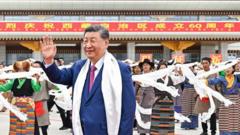In a high-profile and unexpected trip to Tibet, President Xi Jinping championed themes of unity and development in front of a crowd of 20,000 in Lhasa. This visit marks a significant milestone as it commemorates 60 years since the establishment of the Tibet Autonomous Region following China’s annexation. Xi, only the second Chinese president to visit Tibet, acknowledged the local government's efforts in combatting separatism—a nod to the long-standing resistance against Beijing's rule in the region.
Xi's visit comes at a time of heightened tensions, particularly after the Dalai Lama recently declared that his office would be responsible for selecting his successor, openly challenging China's authority over Tibetan leadership. The Chinese government maintains that only they hold the power to influence this significant decision. Notably, Xi did not mention the Dalai Lama during his address, signaling a strategic omission amid the ongoing dialogue surrounding Tibetan autonomy.
"The pillars of governance in Tibet necessitate maintaining political and social stability, along with creating ethnic unity and religious harmony," Xi stated, reflecting his administration's perspective. This visit not only aimed to reinforce control in this politically sensitive region but also to encourage economic and cultural engagements, emphasizing the promotion of a unified national language and identity.
The Communist Party of China (CPC) has for years claimed enhancements in the living conditions of Tibetan peoples under its governance and has consistently denied allegations of human rights abuses. However, reports from human rights advocates suggest a contrasting narrative, citing systematic repression and loss of cultural identity among Tibetans.
As part of the visit’s agenda, Xi articulated the CPC’s strategic focus on four primary aims for Tibet: stability, development, ecological preservation, and border security. These objectives were underscored by discussions on new education directives mandating that Tibetan children learn Mandarin in state-run institutions.
Moreover, the unveiling of plans for the construction of the world’s largest dam in Tibet, the Motuo Hydropower Station, further emphasizes Beijing's ambitious projects in the region, which they claim will spur local prosperity and ecological safeguards. However, concerns have arisen regarding the potential geopolitical ramifications of the dam, particularly its ability to control water flow into neighboring countries, including India and Bangladesh.
Xi's visit has sparked widespread coverage in state media, showcasing him engaging with enthusiastic local populations, including traditional dancers, and receiving a warm welcome. Yet, the backdrop of this visit remains complicated by interethnic tensions, historical grievances, and the broader narratives surrounding China’s governance and control over Tibet.

















